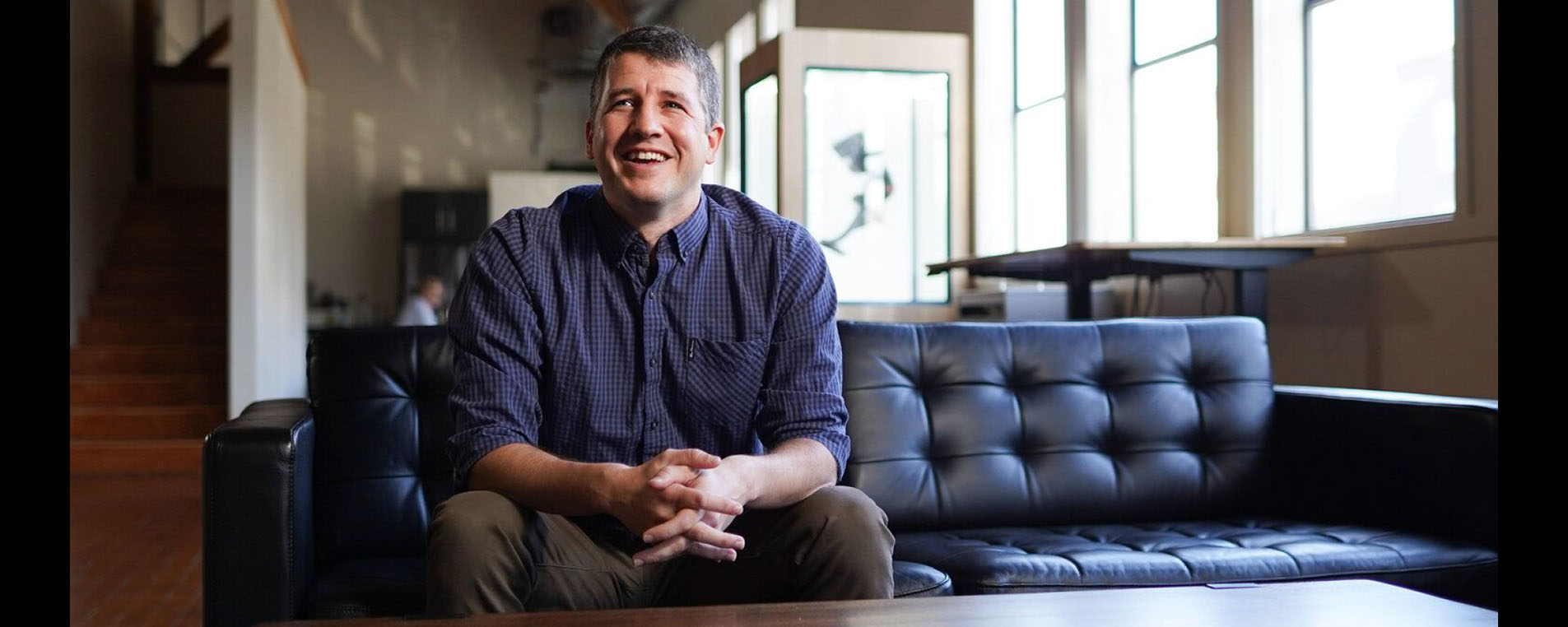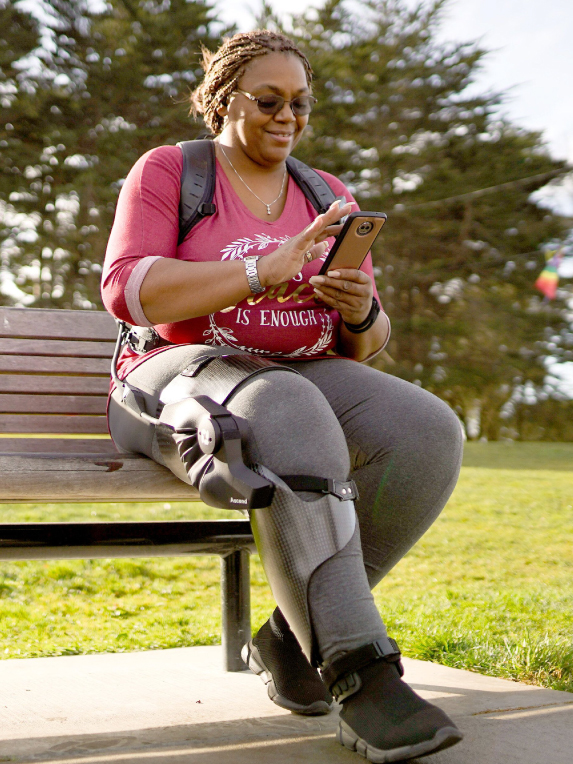
The wearable robots that are helping Navy SEALs double their strength and endurance
Exoskeletons are also helping everyday people get on with their lives.
By Alison Coleman
By Alison Coleman

Tim Swift is pushing the limits of robotics and exoskeleton design. Photo source: Roam Robotics
Tim Swift remembers when he taught the robot Ekso to walk.
“My son was learning to walk at the time. I would watch him teetering around the house, and I’d see him fall. I have these vivid memories of my wife running into the room because he was crying, asking me why I was just sitting there and staring at him. What I was actually doing was trying to work out what his brain was doing as he was trying to walk.”
Ekso was a lower-extremity rigid exoskeleton developed for gait rehabilitation and paraplegic mobility. The technology was designed to allow wheelchair users, including those suffering from spinal cord injury, to regain basic movements and even the ability to walk again.
However, the robot cost in excess of $100,000. It was as heavy as a bookshelf and moved at just over half a mile per hour. It wasn’t practical for day-to-day use. Swift was dejected at his inability to make a real-world impact in the lives of people.
Today, that has changed with Roam Robotics, a company that Swift founded in 2013. The company’s Ascend smart knee orthosis product has been labeled as a “game changer for millions of Americans with knee osteoarthritis” by NPR.
According to a report in Science magazine, almost 20% of people in America suffer from knee osteoarthritis, a condition in which the joint cartilage breaks down. Knee osteoarthritis is a degenerative condition that worsens over time, and people often find it difficult to walk, climb, and perform the most basic day-to-day tasks. Ascend offers them a way out: a recent clinical study shows that the participants with knee osteoarthritis show 46% average pain reduction while wearing Ascend.
Roam Robotics has also developed Forge. The product is designed to boost the performance of military personnel and first responders. Forge’s exoskeleton is designed to deliver a 2x improvement in strength and endurance, while reducing the g-forces experienced by the wearer by as much as 50%.
“My son was learning to walk at the time. I would watch him teetering around the house, and I’d see him fall. I have these vivid memories of my wife running into the room because he was crying, asking me why I was just sitting there and staring at him. What I was actually doing was trying to work out what his brain was doing as he was trying to walk.”
Ekso was a lower-extremity rigid exoskeleton developed for gait rehabilitation and paraplegic mobility. The technology was designed to allow wheelchair users, including those suffering from spinal cord injury, to regain basic movements and even the ability to walk again.
However, the robot cost in excess of $100,000. It was as heavy as a bookshelf and moved at just over half a mile per hour. It wasn’t practical for day-to-day use. Swift was dejected at his inability to make a real-world impact in the lives of people.
Today, that has changed with Roam Robotics, a company that Swift founded in 2013. The company’s Ascend smart knee orthosis product has been labeled as a “game changer for millions of Americans with knee osteoarthritis” by NPR.
According to a report in Science magazine, almost 20% of people in America suffer from knee osteoarthritis, a condition in which the joint cartilage breaks down. Knee osteoarthritis is a degenerative condition that worsens over time, and people often find it difficult to walk, climb, and perform the most basic day-to-day tasks. Ascend offers them a way out: a recent clinical study shows that the participants with knee osteoarthritis show 46% average pain reduction while wearing Ascend.
Roam Robotics has also developed Forge. The product is designed to boost the performance of military personnel and first responders. Forge’s exoskeleton is designed to deliver a 2x improvement in strength and endurance, while reducing the g-forces experienced by the wearer by as much as 50%.

Forge is designed to boost the performance of military personnel and first responders. Photo source: Roam Robotics
Swift spoke to the Amazon re:MARS team about wearable robots and the evolution of his ideas from concept to a tangible reality.
What do you mean by the term “wearable robot”?
A wearable robot or exoskeleton is a mechatronic system designed around the shape and function of the human body. The segments and joints in an exoskeleton correspond to those of the person wearing it. Traditionally, exoskeletons were made from metal and powered by electric and hydraulic systems. However, these products were heavy and did little in the way of enhancing mobility. Roam’s wearable robotic devices are created using high-strength fabrics, plastics, and air compression. This makes them lightweight yet powerful. As a result, they can be more easily integrated into everyday life.
The technology is powered by machine learning. We generate insights from user mobility data and optimizing device performance based on recommendations from our algorithms. This allows our devices to work seamlessly with the human body, which is less hindered by physical restrictions.
Humans wearing robots—are we talking about cyborgs here?
I get asked that question a lot, and the answer is an emphatic “no.” We are actually doing the complete opposite of creating cyborgs. Building cyborgs is about making a person less human. If anything, wearable exoskeletons make people more human.
Roam’s first customer-facing product, released in 2018, was Elevate, a robotic ski exoskeleton designed to boost quad muscle strength, giving the wearer more control and the ability to make stronger turns and longer runs, while reducing muscle fatigue and joint pressure. A pneumatic actuator inside the device works as an air spring, deflating when knees are bending and inflating when they are straightened, contributing to the power that our muscles need while skiing.
The technology behind Elevate can augment the experience for skiers who are looking to push the edges of what’s possible. And just as gratifying, it can allow older skiers to turn back the years and ski the way they did 20 years earlier.
How can wearable robotics restore some capabilities for individuals?
We developed Ascend, a smart knee orthosis designed for osteoarthritis sufferers that can help to reduce knee pain and improve mobility. Ascend’s technology is actively adaptive, so it can sense the body’s movement and automatically adjust to the wearer’s needs. It provides precise support at the right moment for target muscle groups, for example, while kneeling down, getting in and out of chairs, and climbing and descending stairs.
What do you mean by the term “wearable robot”?
A wearable robot or exoskeleton is a mechatronic system designed around the shape and function of the human body. The segments and joints in an exoskeleton correspond to those of the person wearing it. Traditionally, exoskeletons were made from metal and powered by electric and hydraulic systems. However, these products were heavy and did little in the way of enhancing mobility. Roam’s wearable robotic devices are created using high-strength fabrics, plastics, and air compression. This makes them lightweight yet powerful. As a result, they can be more easily integrated into everyday life.
The technology is powered by machine learning. We generate insights from user mobility data and optimizing device performance based on recommendations from our algorithms. This allows our devices to work seamlessly with the human body, which is less hindered by physical restrictions.
Humans wearing robots—are we talking about cyborgs here?
I get asked that question a lot, and the answer is an emphatic “no.” We are actually doing the complete opposite of creating cyborgs. Building cyborgs is about making a person less human. If anything, wearable exoskeletons make people more human.
Roam’s first customer-facing product, released in 2018, was Elevate, a robotic ski exoskeleton designed to boost quad muscle strength, giving the wearer more control and the ability to make stronger turns and longer runs, while reducing muscle fatigue and joint pressure. A pneumatic actuator inside the device works as an air spring, deflating when knees are bending and inflating when they are straightened, contributing to the power that our muscles need while skiing.
The technology behind Elevate can augment the experience for skiers who are looking to push the edges of what’s possible. And just as gratifying, it can allow older skiers to turn back the years and ski the way they did 20 years earlier.
How can wearable robotics restore some capabilities for individuals?
We developed Ascend, a smart knee orthosis designed for osteoarthritis sufferers that can help to reduce knee pain and improve mobility. Ascend’s technology is actively adaptive, so it can sense the body’s movement and automatically adjust to the wearer’s needs. It provides precise support at the right moment for target muscle groups, for example, while kneeling down, getting in and out of chairs, and climbing and descending stairs.

Ascend is a smart knee orthosis designed for osteoarthritis sufferers that can help to reduce knee pain and improve mobility. Photo source: Roam Robotics
There are around 200 million symptomatic knee arthritis patients in the world today. About a third—60 million—are what we term “treatment gap” patients. That means they’ve outlived bracing and physical therapy, because it doesn’t help them anymore.
The only intervention that they have is total knee replacement, which is effective, but extremely invasive and involves opioid-based drugs, neither of which are ideal life choices.
With Ascend, we have created a non-invasive, non-surgical, low-risk option for all of these people, one that will give them a new outlook on life.
The benefits go beyond an improved range of mobility. Improved mobility has been shown to positively impact other areas of health: for example, reducing the risk of certain cancers, Type 2 diabetes and osteoporosis, while improving cardiovascular and mental health.
What are some of the challenges that you had to overcome while developing Roam products?
Once we had realized the full potential of the new technology, we started building a general prototype that could be used to test a wide range of activities from skiing to biking and even motor racing. We put our wearable robots on patients suffering from osteoarthritis, and we put it on Navy SEALs.
During this process, we introduced what we call the “suck test.” We passed the suck test when someone used the robot, and described their experience without using the word “suck” to describe it.
It was tough, because people are picky, especially folk who expect to have very dynamic mobility. However, as we started rolling out Elevate, we found that our test criteria changed. Instead of the suck test, we had the “magic test.” If they didn’t describe their experience or some part of it as magic, we were probably in the wrong place, because, for a typical Elevate customer, it’s magical to see a massive reduction in perceived pain.
We achieved similar positive outcomes when we started working on our performance products with elite military units like the Navy SEALs. These guys are always battling uneven environments. They are hiking around with a lot of weight. Oftentimes, they are at sea on small boats that are racing to get to the site of their mission. Our collaboration led to the development of Forge, a sister product for the US military, built to increase the endurance, speed, and strength of our soldiers. As an added bonus, we also found Forge to boost the performance of our first responders.
The biggest challenge at every step along the journey was making these products affordable. I’d never forgotten my experience with Ekso and how most people would have to continue using their wheelchair because they couldn’t afford the product. At Roam Robotics, we’ve really pushed the boundaries that make these products affordable to most people.
It’s a great start; however, I believe that we are just scratching the surface of what is possible.
The only intervention that they have is total knee replacement, which is effective, but extremely invasive and involves opioid-based drugs, neither of which are ideal life choices.
With Ascend, we have created a non-invasive, non-surgical, low-risk option for all of these people, one that will give them a new outlook on life.
The benefits go beyond an improved range of mobility. Improved mobility has been shown to positively impact other areas of health: for example, reducing the risk of certain cancers, Type 2 diabetes and osteoporosis, while improving cardiovascular and mental health.
What are some of the challenges that you had to overcome while developing Roam products?
Once we had realized the full potential of the new technology, we started building a general prototype that could be used to test a wide range of activities from skiing to biking and even motor racing. We put our wearable robots on patients suffering from osteoarthritis, and we put it on Navy SEALs.
During this process, we introduced what we call the “suck test.” We passed the suck test when someone used the robot, and described their experience without using the word “suck” to describe it.
It was tough, because people are picky, especially folk who expect to have very dynamic mobility. However, as we started rolling out Elevate, we found that our test criteria changed. Instead of the suck test, we had the “magic test.” If they didn’t describe their experience or some part of it as magic, we were probably in the wrong place, because, for a typical Elevate customer, it’s magical to see a massive reduction in perceived pain.
We achieved similar positive outcomes when we started working on our performance products with elite military units like the Navy SEALs. These guys are always battling uneven environments. They are hiking around with a lot of weight. Oftentimes, they are at sea on small boats that are racing to get to the site of their mission. Our collaboration led to the development of Forge, a sister product for the US military, built to increase the endurance, speed, and strength of our soldiers. As an added bonus, we also found Forge to boost the performance of our first responders.
The biggest challenge at every step along the journey was making these products affordable. I’d never forgotten my experience with Ekso and how most people would have to continue using their wheelchair because they couldn’t afford the product. At Roam Robotics, we’ve really pushed the boundaries that make these products affordable to most people.
It’s a great start; however, I believe that we are just scratching the surface of what is possible.
